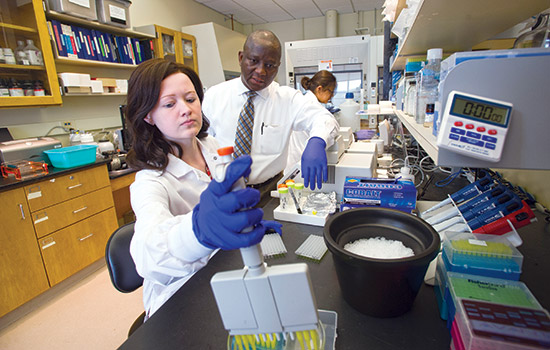Biomedical sciences a pathway to medical careers
A. Sue Weisler
Tara Snyder ’17 (biomedical sciences), left, conducted research on sickle cell disease and malaria with Bolaji Thomas, associate professor of biomedical sciences. Thomas has established an independent immunology research program focused on the training of undergraduate students.
Tara Snyder ’17 (biomedical sciences) planned to go to medical school until her sophomore year at RIT.
She had started volunteering on the pediatric floors at the Golisano Children’s Hospital in Rochester, N.Y., and realized that she would rather pursue medical research and then go to nursing school and specialize in pediatrics.
“I saw more patient interaction from the nurses than the doctors—and I’ve been there at all times of the day—and I think it’s more of what I wanted, to have the patient interactions and the science behind it,” Snyder said.
Now she hopes to enter a post-baccalaureate research program at University of Pennsylvania as a precursor to nursing school next fall.
Biomedical sciences is the biggest program in the College of Health Sciences and Technology with approximately 260 enrolled students, and that number is expected to grow, said Douglas Merrill, professor of biomedical sciences.
“The U.S. Department of Labor Statistics predicts that health care will continue to be a driver of the U.S. economy well into the future,” he said.
The program is designed to give students a pathway for pursing clinical doctoral degrees in medicine, dentistry, pharmacy and physical therapy, as well as graduate degrees in nursing, physician assistant, occupational therapy and medical research.
The biomedical sciences curriculum covers the prerequisite biology, chemistry, organic chemistry and physics courses students need for their next step. Advanced undergraduate classes in immunology, endocrinology and human gross anatomy, where students learn on a cadaver, create a rigorous foundation for all health careers.
Merrill and Richard Doolittle, currently the vice dean of the College of Health Sciences and Technology, were instrumental in developing and launching the program in 2006 in the College of Science, before the College of Health Sciences and Technology was created.
Merrill recruited Robert Osgood, associate professor and the current director of the biomedical sciences program, nearly a decade ago. Since then, Osgood has established a busy lab on campus and conducts research at Rochester General Hospital through the RIT & Rochester Regional Health Alliance.
His focus on research represents the next phase of the program—educating biomedical research scientists who go on for their Ph.D. degrees.
Snyder conducted research on sickle cell disease and malaria with Bolaji Thomas, associate professor of biomedical sciences. She presented a poster on her research last April at the Experimental Biology Conference in Chicago.
Since 2008, Thomas has established an independent immunology research program, primarily focused on the training and mentoring of undergraduate researchers like Snyder.
Many of his former students are currently enrolled in graduate programs.
“I bring data from my lab into class to show students that what we’re teaching them is not just theory but has practical application, and they respond very seriously,” Thomas said. “And so they can appreciate the application in clinical medicine, immunology and in health care.”












